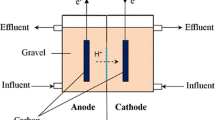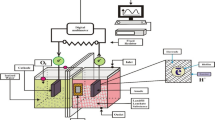Abstract
The emission of the source effluent of azo dyes has resulted in a serial of environmental problems including of the direct damage of the natural esthetics, the inhibition of the oxygen exchange, the shortage of the photosynthesis, and the reduction of the aquatic flora and fauna. A bioelectrochemical platform (3D-EF-MFCs) combining two-chamber microbial fuel cells and three dimensional electro-Fenton technique were delicately designed and assembled to explore the decolorization, bio-genericity performance of the methyl orange, and the possible biotic-abiotic degradation mechanisms. The 3D-EF-MFCs processes showed higher decolorization efficiencies, COD removals, and better bioelectricity performance than the pure electro-Fenton-microbial fuel cell (EF-MFC) systems. The two-chamber experiments filling with the granular activated carbons were better than the single-chamber packing system on the whole. The moderate increase of Fe2+ ions dosing in the cathode chamber accelerated the formation of •OH, which further enhanced the degradation of the methyl orange (MO). The cathode-decolorization and COD removals were decreased with the increase of MO concentration. However, the degradation performance of MO was indirectly improved in the anode compartment at the same conditions. The bed electrodes played a mediator role in the anode and cathode chambers, certainly elevated the voltage output and the power density, and lowered the internal impedance of EF-MFC process.








Similar content being viewed by others
References
Arslan M, Sayin S, Yilmaz M (2013) Removal of carcinogenic azo dyes from water by new cyclodextrin-immobilized iron oxide magnetic nanoparticles. Water Air Soil Pollut 224
Baicha Z, Salar-Garcia M, Ortiz-Martinez VM, Hernandez-Fernandez F, de los Rios AP, Labjar N, Lotfi E, Elmahi M (2016) A critical review on microalgae as an alternative source for bioenergy production: a promising low cost substrate for microbial fuel cells. Fuel Process Technol 154:104–116
Chmayssem A, Taha S, Hauchard D (2017) Scaled-up electrochemical reactor with a fixed bed three-dimensional cathode for electro-Fenton process: application to the treatment of bisphenol A. Electrochim Acta 225:435–442
Choudhury P, Uday USP, Mahata N, Tiwari ON, Ray RN, Bandyopadhyay TK, Bhunia B (2017) Performance improvement of microbial fuel cells for waste water treatment along with value addition: a review on past achievements and recent perspectives. Renew Sust Energ Rev 79:372–389
Doherty L, Zhao YQ, Zhao XH, Hu YS, Hao XD, Xu L, Liu RB (2015) A review of a recently emerged technology: constructed wetland - microbial fuel cells. Water Res 85:38–45
Ferrer-Polonio E, Iborra-Clar A, Mendoza-Roca JA, Iborra-Clar MI (2015) Combination of adsorption and biological treatment in a SBR for colour elimination in municipal wastewater with discharges of textile effluents. Desalin Water Treat 55:1915–1921
Haddaji D, Bousselmi L, Saadani O, Nouairi I, Ghrabi-Gammar Z (2015) Enzymatic degradation of azo dyes using three macrophyte species: Arundo donax, Typha angustifolia and Phragmites australis. Desalin Water Treat 53:1129–1138
Hou BL, Han HJ, Zhuang HF, Xu P, Jia SY, Li K (2015) A novel integration of three-dimensional electro-Fenton and biological activated carbon and its application in the advanced treatment of biologically pretreated Lurgi coal gasification wastewater. Bioresour Technol 196:721–725
Hou BL, Ren BZ, Deng RJ, Zhu GC, Wang ZH, Li Z (2017) Three-dimensional electro-Fenton oxidation of N-heterocyclic compounds with a novel catalytic particle electrode: high activity, wide pH range and catalytic mechanism. RSC Adv 7:15455–15462
Kumar R, Singh L, Wahid ZA, Din MFM (2015) Exoelectrogens in microbial fuel cells toward bioelectricity generation: a review. Int J Energy Res 39:1048–1067
Lade H, Govindwar S, Paul D (2015) Mineralization and detoxification of the carcinogenic azo dye Congo red and real textile effluent by a polyurethane foam immobilized microbial consortium in an upflow column bioreactor. Int J Environ Res Public Health 12:6894–6918
Li M, Sun XB, Qian FY, Xu HY, Liu YD (2013) Characteristic of dissolved organic matters removal from bio-treated effluents of textile and dyeing wastewater by coagulation enhanced with KMnO4. Asian J Chem 25:10095–10101
Li Y, Li G, Li W, Yang F, Liu HH (2015) Greenly synthesized gold-alginate nanocomposites catalyst for reducing decoloration of azo-dyes. Nano 10:1550108
Li XH, Jin XD, Zhao NN, Angelidaki I, Zhang YF (2017) Novel bio-electro-Fenton technology for azo dye wastewater treatment using microbial reverse-electrodialysis electrolysis cell. Bioresour Technol 228:322–329
Manenti DR, Modenes AN, Soares PA, Boaventura RAR, Palacio SM, Borba FH, Espinoza-Quinones FR, Bergamasco R, Vilar VJP (2015) Biodegradability and toxicity assessment of a real textile wastewater effluent treated by an optimized electrocoagulation process. Environ Technol 36:496–506
Mata AMT, Ligneul A, Lourenco ND, Pinheiro HM (2017) Advanced oxidation for aromatic amine mineralization after aerobic granular sludge treatment of an azo dye containing wastewater. Desalin Water Treat 91:168–174
Murali V, Ong SA, Ho LN, Wong YS, Hamidin N (2013) Comprehensive review and compilation of treatment for azo dyes using microbial fuel cells. Water Environ Res 85:270–277
Omerogiu S, Sanin FD (2016) Bioelectricity generation from wastewater sludge using microbial fuel cells: a critical review. Clean Soil Air Water 44:1225–1233
Papic S, Peternel I, Krevzelj Z, Kusic H, Koprivanac N (2014) Advanced oxidation of an azo dye and its synthesis intermediates in aqueous solution: effect of Fenton treatment on mineralization, biodegradability and toxicity. Environ Eng Manag J 13:2561–2571
Pizarro AH, Molina CB, Rodriguez JJ (2016) Decoloration of azo and triarylmethane dyes in the aqueous phase by catalytic hydrotreatment with Pd supported on pillared clays. RSC Adv 6:113820–113825
Qiao N, Ma H, Hu M (2015) Design of a neutral three-dimensional electro-Fenton system with various bentonite-based Fe particle electrodes: a comparative study. Mater Res Innov:19
Rostamizadeh M, Jafarizad A, Gharibian S (2018) High efficient decolorization of reactive red 120 azo dye over reusable Fe-ZSM-5 nanocatalyst in electro-Fenton reaction. Sep Purif Technol 192:340–347
Santoro C, Arbizzani C, Erable B, Ieropoulos I (2017) Microbial fuel cells: from fundamentals to applications. A review. J Power Sources 356:225–244
Sen SK, Raut S, Bandyopadhyay P, Raut S (2016) Fungal decolouration and degradation of azo dyes: a review. Fungal Biol Rev 30:112–133
Shen LH, Yan P, Guo XB, Wei HX, Zheng XF (2014) Three-dimensional electro-Fenton degradation of methylene blue based on the composite particle electrodes of carbon nanotubes and Nano-Fe3O4. Arab J Sci Eng 39:6659–6664
Singh RL, Singh PK, Singh RP (2015) Enzymatic decolorization and degradation of azo dyes—a review. Int Biodeter Biodegr 104:21–31
Xu HD, Quan XC, Xiao ZT, Chen L (2017) Cathode modification with peptide nanotubes (PNTs) incorporating redox mediators for azo dyes decolorization enhancement in microbial fuel cells. Int J Hydrog Energy 42:8207–8215
Yang CW, Wang D, Tang Q, Sun YW (2017) Decoloration of azo dye methyl orange by a novel electro-Fenton internal circulation batch reactor. J Adv Oxid Technol 20
Yu ZY, Wang WH, Song L, Lu LQ, Wang ZY, Jiang XF, Dong CN, Qiu RY (2013) Acceleration comparison between Fe2+/H2O2 and Co2+/oxone for decolouration of azo dyes in homogeneous systems. Chem Eng J 234:475–483
Author information
Authors and Affiliations
Corresponding author
Additional information
Responsible editor: Vítor Pais Vilar
Electronic supplementary material
ESM 1
(DOCX 117 kb)
Rights and permissions
About this article
Cite this article
Huang, T., Liu, L., Tao, J. et al. Microbial fuel cells coupling with the three-dimensional electro-Fenton technique enhances the degradation of methyl orange in the wastewater. Environ Sci Pollut Res 25, 17989–18000 (2018). https://doi.org/10.1007/s11356-018-1976-4
Received:
Accepted:
Published:
Issue Date:
DOI: https://doi.org/10.1007/s11356-018-1976-4




